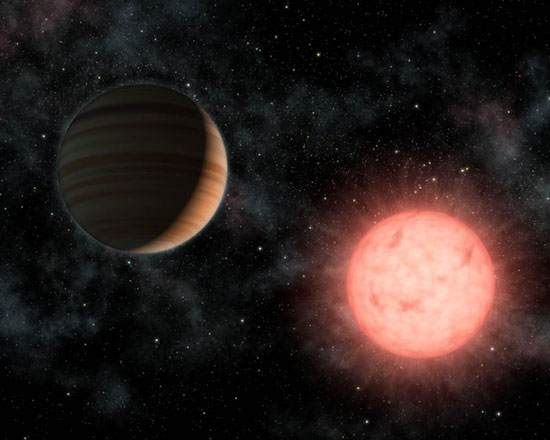Discovery: Even Tiny Stars Have Planets

AJupiter-like planet has been discovered orbiting one of the smallest starsknown, suggesting that planets could be more common than previously thought.
This exoplanetfinding is the first discovery for a long-proposed tool for huntingplanets, called astrometry.
"Thisis an exciting discovery because it shows that planets can be found aroundextremely lightweight stars," said Wesley Traub, the chief scientist forNASA's Exoplanet Exploration Program at Jet Propulsion Laboratory in Pasadena, Calif. "This is a hint that nature likes to form planets, even around starsvery different from the sun."
Long-awaitedsuccess
Astrometry wasfirst attempted 50 years ago to search for planets outside our solar system, butthe method requires very precise measurements over long periods of time, anduntil now, has failed to turn up any exoplanets.
Thetechnique involves measuringthe precise motions of a star on the sky as an unseen planet tugs the starback and forth.
A team oftwo astronomers from JPL has, for the past 12 years, been mounting anastrometry instrument to a telescope at the Palomar Observatory near San Diego. After careful, intermittent observations of 30 stars, the team has identified anew exoplanet around one of them.
Get the Space.com Newsletter
Breaking space news, the latest updates on rocket launches, skywatching events and more!
"Thismethod is optimal for finding solar-system configurations like ours that mightharbor other Earths," said team member Steven Pravdo of JPL. "Wefound a Jupiter-like planet at around the same relative place as our Jupiter,only around a much smaller star. It's possible this star also has inner rockyplanets. And since more than seven out of 10 stars are small like this one,this could mean planets are more common than we thought."
Thediscovery will be detailed in the Astrophysical Journal.
Thenewfound exoplanet, called VB 10b, is about 20 light-years away in theconstellation Aquila (a light-year is the distance that light travels in ayear, about 6 trillion miles or 10 trillion kilometers). It is a gas giant,with a mass six times that of Jupiter, and an orbit far enough away from itsstar to be labeled a "cold Jupiter" similar to our own.
In reality,though, the planet's own internal heat would give it an Earth-like temperature.
Theplanet's star, called VB 10, is tiny. It is what's known as an M-dwarf and isonly one-twelfth the mass of our sun, just barely big enough to fuse atoms atits core and shine with starlight.
Minisolar system
For years,VB 10 was the smallest star known ? now it has a new title: the smallest starknown to host a planet. In fact, though the star is more massive than thenewfound planet, the two bodies would have a similar girth.
Because thestar is so small, its planetary system would be a miniature, scaled-downversion of our own.
Forexample, VB 10b, though considered a cold Jupiter, is located about as far fromits star as Mercury is from the sun. (In contrast, so-called "hotJupiters" orbit so close to their stars that their surfaces arethought to be scorching.) Any rocky Earth-size planets that might happen to bein the neighborhood would lie even closer in.
"Otherknown exoplanets around larger M-dwarf stars are also similar to our Jupiter,making the stars fertile ground for future Earth searches," said teammember Stuart Shaklan, also of JPL. "Astrometry is best suited to findcold Jupiters around all kinds of stars, and thus to find more planetarysystems arranged like our home."
Tinymovements
Two to sixtimes a year, for the past 12 years, Pravdo and Shaklan have bolted theirStellar Planet Survey instrument onto Palomar's five-meter Hale telescope tosearch for planets.
Theinstrument, which has a 16 megapixel charge-coupled device, or CCD, can detectvery minute changes in the positions of stars. The VB 10b planet, for instance,causes its star to wobble a small fraction of a degree. Detecting this wobbleis equivalent to measuring the width of a human hair from about 1.8 miles, or threekilometers, away.
Otherground-based planet-hunting techniques in wide use include radial velocity andthe transit method. These methods have discovered more than 300 extrasolarplanets to date.
Likeastrometry, radial velocity detects the wobble of a star, but it measuresDoppler shifts in the star's light caused by motion toward and away from us.
The transitmethod looks for dips in a star's brightness as orbiting planets pass by andblock the light. NASA's space-based Kepler mission, which began searching forplanets on May 12, will use the transit method to look for Earth-like worldsaround stars similar to the sun.
- Video ? NASA's Kepler: Hunting Alien Earths
- Out There: Billions and Billions of Habitable Planets
- Top 10 Most Intriguing Extrasolar Planets
Join our Space Forums to keep talking space on the latest missions, night sky and more! And if you have a news tip, correction or comment, let us know at: community@space.com.

Space.com is the premier source of space exploration, innovation and astronomy news, chronicling (and celebrating) humanity's ongoing expansion across the final frontier. Originally founded in 1999, Space.com is, and always has been, the passion of writers and editors who are space fans and also trained journalists. Our current news team consists of Editor-in-Chief Tariq Malik; Editor Hanneke Weitering, Senior Space Writer Mike Wall; Senior Writer Meghan Bartels; Senior Writer Chelsea Gohd, Senior Writer Tereza Pultarova and Staff Writer Alexander Cox, focusing on e-commerce. Senior Producer Steve Spaleta oversees our space videos, with Diana Whitcroft as our Social Media Editor.









